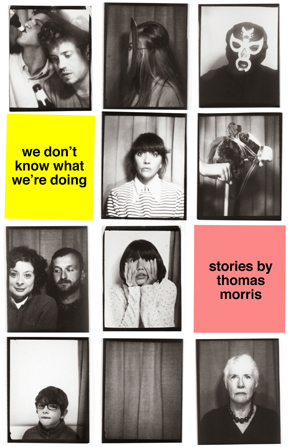53 ways to improve your short stories
by Thomas MorrisThe author of We Don’t Know What We’re Doing has thought quite a bit about how best to approach writing short fiction. We asked him to compile a list of do’s and don’ts and suggested reading that might help practitioners at any stage of their craft.
1. Read Flannery O’Connor. Now.
2. All characters think that they’re the main characters. Have them behave that way. (I think this is a quote from Anne Tyler.)
3. The exception to the above is for characters who themselves don’t feel like the main characters in their own lives – in which case, this is also very interesting. Show us what it’s like to live this way.
4. Delete your first paragraph.
5. Delete your final paragraph.
6. Is that an animal you have there? Ooh, is it symbolic? Are you going to kill it at the end? Forget it.
7. If the aim of your story is to show us the boredom of life, you have to ensure that the reader won’t be so bored as to not finish the story. Give them some kind of reward (be it on the level of language, insight, character, or just something).
8. Allow psychology to become behaviour. That way something will actually happen.
9. Exchange your short stories with your peers/friends. You will see your own flaws in their work much quicker than you’ll see them in your own.
10. Where possible, avoid having characters with names beginning with the same letter as each other. It’s just less confusing this way.
11. Is it clear to the reader how old, roughly, your character is? If not, is this a problem?
12. If you’ve written your story in present tense, rewrite a few of the paragraphs in past tense and see which details aren’t necessary (e.g. do we need the woman walking across the room and then back again? If this were a film, it’d cost £10,000 just to film that 5 seconds of footage.)
13. Look at every sentence you have written. Do any of the sentences contain a phrase you’ve read or heard before? If the sentence belongs to a character, it’s maybe excusable. If not, rephrase.
14. Does your title expand the meaning of the story? Or does it make the story smaller?
15. If a detail or feeling seems too complicated or fiddly to explain, then you MUST NOT SHIRK AWAY. This is where you’ll find the stuff that’s actually real. Nuance the shit out of it.
16. Don’t set out to write a story to teach the reader something. That’s didactic and boring.
17. In speech, people talk over each other, interrupt, disagree, and don’t always answer directly the questions they’re asked. The same should be true for dialogue.
18. Consider the white space on your page. Dialogue can give the reader’s eye a break. But maybe you don’t want to give them a break?
19. Re-read your final paragraph. Be honest with yourself: have you ripped off the ending of ‘The Dead’ or American Beauty?
A thousand words describing two characters sitting at a table or three scenes, three hundred words each, of the same two characters in different settings? Consider the pros and cons.”
20. If done correctly, the very form of your story can carry/become the story itself.
21. Read Donald Barthelme’s Sixty Stories.
22. When your story is about someone returning somewhere, do not call it ‘The Prodigal Son’, or ‘The Prodigal Daughter’, or the prodigal anything. Please.
23. Quit writing stories to fit stupid word counts. Let the story go as long or as short as it needs to be. If the story works, you will find a good home for it.
24. Exposition is always difficult. Try and find interesting ways to hide/obscure the exposition. (Note: a radio or TV broadcast does not count as an ‘interesting’ way.)
25. Read Patrick Davey’s interview with George Saunders in Bomb magazine (the interview is in two parts; be sure to read the second part too).
26. People are often amusing in real life. It’s worth remembering.
27. Realism is just a mode. All modes are as valid as each other. The important thing is to tell the story in the way it needs to be told. You mightn’t know how it needs to be told until you’ve finished the first or second or fifteenth draft. This is completely normal.
28. It’s amazing what a paragraph break can do. You can write 400 words of transition, explaining how the woman got from the beach back to the apartment, or you can just put in a paragraph break and begin the next section with, “The apartment was warm…”
29. When you’re writing in first person you can often fool yourself into thinking that the character leaps off the page. Rewrite a few of the paragraphs in third person and see if this is still the case. It might well be that you’ve just used the first person narrator as a director uses a camera.
30. Though, that said, the things the character sees and notices will reveal their character. Or rather: these things are always an opportunity to show us something about that character.
31. Sometimes, one telling line will save you the hassle of 14 lines of showing.
32. Don’t get hung up on your ‘original intention’ for a story or scene. If something more interesting emerges, go with it. We shouldn’t all marry our first loves.
33. Count how many characters you have in your story. Can any of the characters be merged?
34. Saying that someone is “wearing a business suit” does not count as description.
35. Read Ali Smith’s short stories.
36. A short story lives and dies in the cadences of each sentence. Read your story aloud. Find the bum notes.
37. Be aware of how narrow your reading taste can become (mine, for example are way too American). Broaden your tastes.
38. A character lying in bed being sad is not yet a story.
39. ‘Metamorphosis’ by Franz Kafka is a very good story.
40. No one is as well travelled as they’d like to be. Show the reader what it’s like to inhabit the space/place your characters are currently inhabiting.
41. A thousand words describing two characters sitting at a table vs. three scenes, three hundred words each, of the same two characters in different settings/periods. Consider the pros and cons of both approaches. Maybe you could gain what you need by doing one or the other?
42. Take from your own life. Mercilessly. This is where the pulse, the blood, the life comes from. Furnish the rooms of your stories with the emotional furniture of your mind.
43. Beware extended metaphors.
44. Read ‘Do Not Disturb’ by A.M. Holmes.
45. Re-read stories by your favourite authors. Pay close attention to the craft – dialogue, description, transitions, indirect free speech, etc.
46. Allow all manner of things to influence your stories – music, film, art, TV, conversations, bus rides. If you only allow other stories to inform your stories, you’ll create a hall of empty mirrors.
47. Consequences: if a character goes out in the rain in just a T-shirt, they’ll likely get a cold.
48. Read this story by ZZ Packer in The New Yorker.
49. We don’t always know why people do things, and sometimes the writer needn’t speculate. Show a character’s behaviour and the reader can decide for themselves.
50. Do you feel something when you read your final line? If not, the reader probably won’t either.
51. A lot of writers think the art of the short story rests in being subtle. But there’s such a thing as being too subtle. Consider the volume control – do you need to turn it up a little? (e.g. if the reader has to register and understand the sequence of six separate buried symbols in order to appreciate the story – well, the story’s too quiet.)
52. If your story takes place at a funeral, you can probably cut that scene about the bad sandwiches.
53. Ignore all this. You’re a writer. You’re not here to be told what to do.
 Thomas Morris was born and grew up in in Caerphilly. A graduate of Trinity College, he has lived in Dublin since 2005, where he now edits The Stinging Fly. He also devised and edited Dubliners 100: 15 New Stories Inspired by the Original. His debut story collection We Don’t Know What We’re Doing is published by Faber & Faber. Read more.
Thomas Morris was born and grew up in in Caerphilly. A graduate of Trinity College, he has lived in Dublin since 2005, where he now edits The Stinging Fly. He also devised and edited Dubliners 100: 15 New Stories Inspired by the Original. His debut story collection We Don’t Know What We’re Doing is published by Faber & Faber. Read more.
tolmorris.tumblr.com
@tolmorris
To receive the occasional email and story, subscribe to A Small, Good Thing.


